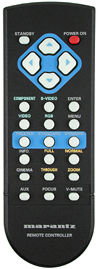Marantz VP-12S2 DLP video front projector Page 2
 The VP-12S2's aspect-ratio modes are designed to let you expand 480i content to fill the screen in a number of ways. Normal displays a 4:3 image in the center of the 16:9 field, while Full stretches it horizontally to fit the full screen. (Use this mode for viewing anamorphic DVDs.) Through simply displays the input signal at its native resolution and aspect ratio, and Zoom enlarges letterboxed 4:3 video content to fit the screen's full width.
The VP-12S2's aspect-ratio modes are designed to let you expand 480i content to fill the screen in a number of ways. Normal displays a 4:3 image in the center of the 16:9 field, while Full stretches it horizontally to fit the full screen. (Use this mode for viewing anamorphic DVDs.) Through simply displays the input signal at its native resolution and aspect ratio, and Zoom enlarges letterboxed 4:3 video content to fit the screen's full width.
These controls will not alter the shape of 720p and 1080i HD signals coming into the Y-Pb-Pr or RGB inputs. But PC signals connected to the projector can be shown as a 4:3 or 5:4 image centered on the 16:9 field, expanded to a widescreen aspect ratio with the Full setting, or viewed with their pixels mapped 1:1 in Through mode. You can also use these modes to play with 480p/60 DTV or DVD content entering the RGB or component input.
Marantz has provided a detailed Fine menu that lets you set many image parameters. In addition to three preset color-temperature choices, you can also dial up red, green, and blue Contrast and Brightness—if you have a color analyzer with color-correction information for the projector's short-arc Super High Pressure (SHP) projection lamp.
You'll also find a black-setup level control, which lets you define black as 0 IRE (the correct setting for viewing RGB sources, such as a computer) or 7.5 IRE (the setting for video and many DVD players). In addition, you can choose one of three gamma settings (Theater, Standard, Dynamic), each of which includes three picture-setting memories. There's also a default set of picture values for each of the three gamma modes.
Although you may not need them, there are a variety of luminance and chrominance "tweaking" controls. You can fuss with the gain and threshold for horizontal and vertical edge and detail to improve the quality of lower-resolution video, such as composite off-air video sources or VHS tapes. These controls are also active with component signals, but they are unavailable with RGB inputs.
[The availability of all these controls is a welcome contrast to the earlier VP-12S1, in which few controls—including color temperature adjustments—were accessible to the user, and Marantz was reluctant to release the service-menu access codes to anyone outside the company. But they also are an invitation for the inexperienced diddler to muck things up. Hint: Write down all of the settings and put them in a safe place before you charge off changing anything—even if you know what you're doing and have the right tools.—TJN]
Picture Quality
I used a variety of signal sources with the VP-12S2. Sony's DVP-S7000 and Panasonic's DVD-RP56 DVD players provided 480i and 480p component-video playback, while a JVC HM-DH30000U D-VHS, connected via FireWire to a Samsung SIR-T165 set-top receiver, was the source for D-VHS and off-air DTV programs. I tested the RGB input with my 866MHz Pentium III PC and an Extron VTG200 test-pattern generator, while HDTV test patterns came from an AccuPel HDG2000 generator.
First off, the deinterlacing and comb-filter circuits in the VP-12S2 were topnotch. Using the Zone Plate pattern from Video Essentials, I saw virtually no cross-color or cross-luminance artifacts with a composite video input from the Sony DVD player, and I saw detail clearly out to 400 lines. In the montage of images, the flag-waving sequence was as clean as if I was playing it back from the Faroudja-equipped Panasonic RP56 DVD player (as it should be—the Marantz also uses Faroudja's DCDi deinterlacing circuitry), and the stadium pan and bridge pan sequences revealed only minor interlaced artifacts. The VP-12S2 also picked up the 3:2 pulldown cadences quickly and cleanly.
Viewing a 6MHz multiburst pattern, I found the VP-12S2 had sufficient bandwidth for all 480i signals. Component HDTV signals were a different story. Using the AccuPel test generator, I discovered that the Marantz couldn't pass much luminance information above 18.5MHz with either 720p or 1080i multiburst patterns. In fact, the 37.5MHz burst was a solid gray.
Worse, I observed evidence of ringing or peaking around lines and shapes that couldn't be eliminated with the edge-enhancement controls. Since I was using a commercial-quality Extron matrix switcher and Belden cables, I can only assume the culprit was an impedance mismatch at the component inputs.
Sure enough, switching to RGB mode made a big improvement. The ringing went away, and I was able to see detail at 18.5MHz. There was also an improvement in fine detail at 37.5MHz with 720p and 1080i signals. Whether this problem was confined to my review sample or symptomatic of production units, I can't say for sure. But you might want to use an RGB connection from your DTV set-top box to ensure that you don't lose fine image detail from HDTV programs.
The VP-12S2 is equipped with a DVI-D input connector (with HDCP) that supports Y-Pb-Pr and RGB formats. I was able to feed 480p/60, 720p/60, and 1080i/30 DTV signals to it from the Samsung T165 tuner. This combination yielded the best image quality of all, particularly with D-VHS tapes on the JVC VCR. If you really want to see what HDTV is capable of—especially some of the 720p material broadcast by ABC that the projector can display without having to do any scaling—use the projector's DVI port and stay out of analog mode altogether.

























































